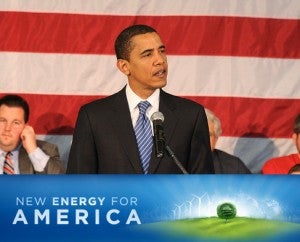Is Government Getting Out Of The Clean Energy Business?

Tuesday’s debt deal makes one thing clear: whatever it is that you may want government to spend money on, there will likely be less money to go around in the future. That said, I think it’s time to rethink government’s role in the clean energy marketplace. Whether or not it has money to spend, governments at all levels can do a lot to build a robust American market for clean energy. Here are some suggested ways forward:
First, engage the private sector. Our government is highly skilled and effective when it comes to enabling clean energy research, which in turn leads to high-risk investments in emerging clean technologies, but it cannot pay for everything. This is not the era of the New Deal, and we’re not China. We are, however, a nation of innovators with the ability to mobilize private capital second to none. So let’s get innovators, entrepreneurs and regulators in a room together and begin to work on projects that establish what economists have been telling us for years: clean energy and efficiency will make and save money. In some places, government can be a convener – for example, cities across the country (and the world) could work with their real estate and banking communities to aggregate efficiency upgrades at a scale large enough to attract major investment from institutional investors and other sources of capital. Government could basically be a source of data and the initial step in drawing parties together to help broker deals
Second, lead by example and cut waste. From energy needed to fuel our troops on the front lines to the air conditioning used for government officials in Washington and state and local capitols – there’s a huge amount of money to be saved and strategic advantage to be won by running our government’s own energy use more effectively. In fact, EDF’s Climate Corps Public Sector is currently engaging in this type of exercise in its efforts to reduce the New York City Housing Authority’s (NYCHA) energy use by more than 45 percent. These types of energy efficiency efforts should appeal to all sides of the political aisle: government will do more with less; we’ll send less money overseas for imported oil; we’ll pioneer new technologies through smart energy applications; and Americans will be put to work upgrading government buildings with less wasteful technology. If there’s a role for money here, it’s to finance upfront costs that get replenished out of energy savings – possibly a mix of private and public capital.
Finally, open the energy marketplace to truly fair competition. America’s utilities are governed by an arcane mix of rules that get in the way of innovation and tend to favor traditional fossil fuels. Our grid is a long way from a smart grid. Don’t even get me started on subsidies for oil and coal companies. Rules that shape the energy market and grid are set at the federal, regional and state levels. It’s time for a national effort to make it easier for households and businesses to use renewable sources of energy like solar and wind, as well as enable drivers to plug in their electric cars. Homes and businesses should be able to sell extra solar electricity into the grid easily and without limit. There should be a simple way to aggregate the benefits of efficiency; for example, consumers should be able to sell saved energy to compete with new power plants and this cleaner energy should be valued by regulators on par with new supply. Consumers should be able to charge electric cars at off-peak times, which could end up costing as little as about three cents a mile to operate. We can have all this – if we get the rules right at Public Utility Commissions (PUCs) across the country.
 The role of government would change. It would become a source of data, culled from public sources like demographics and building department filings. It would help ensure that information is disclosed, like the SEC requires disclosure of information to investors on the stock market. It would change the rules to remove barriers to clean-energy investment inherent in our current electric grids and markets. It would use its bully pulpit not to harangue, but to create the negotiating table around which unlikely partners come together. It would enforce rules clearly and consistently to protect health and environment. It would use its own buildings, agencies, vehicles and supply chain to test and develop technologies – to be out front and demonstrate what works. And where possible, it could be a source of grants or loans, but that role would be overshadowed by the value of the vibrant private energy market that it would support by doing all of these other described duties.
The role of government would change. It would become a source of data, culled from public sources like demographics and building department filings. It would help ensure that information is disclosed, like the SEC requires disclosure of information to investors on the stock market. It would change the rules to remove barriers to clean-energy investment inherent in our current electric grids and markets. It would use its bully pulpit not to harangue, but to create the negotiating table around which unlikely partners come together. It would enforce rules clearly and consistently to protect health and environment. It would use its own buildings, agencies, vehicles and supply chain to test and develop technologies – to be out front and demonstrate what works. And where possible, it could be a source of grants or loans, but that role would be overshadowed by the value of the vibrant private energy market that it would support by doing all of these other described duties.
If the government commits to moving ahead in this way, America will leap ahead in the clean energy sector – and we’ll be moving so fast that its citizens will barely have time to lament the relatively smaller amount of government spending.











